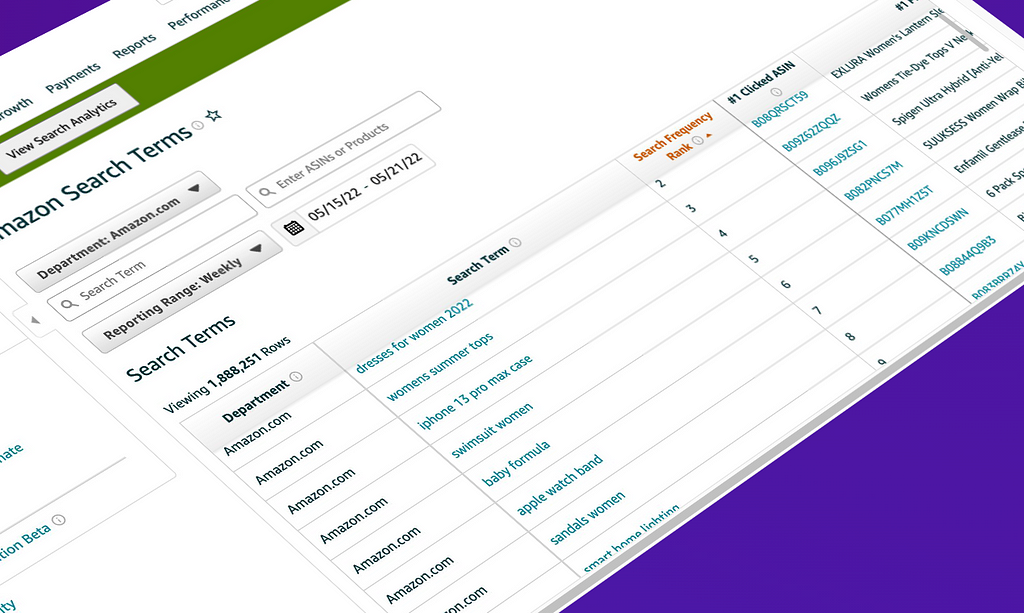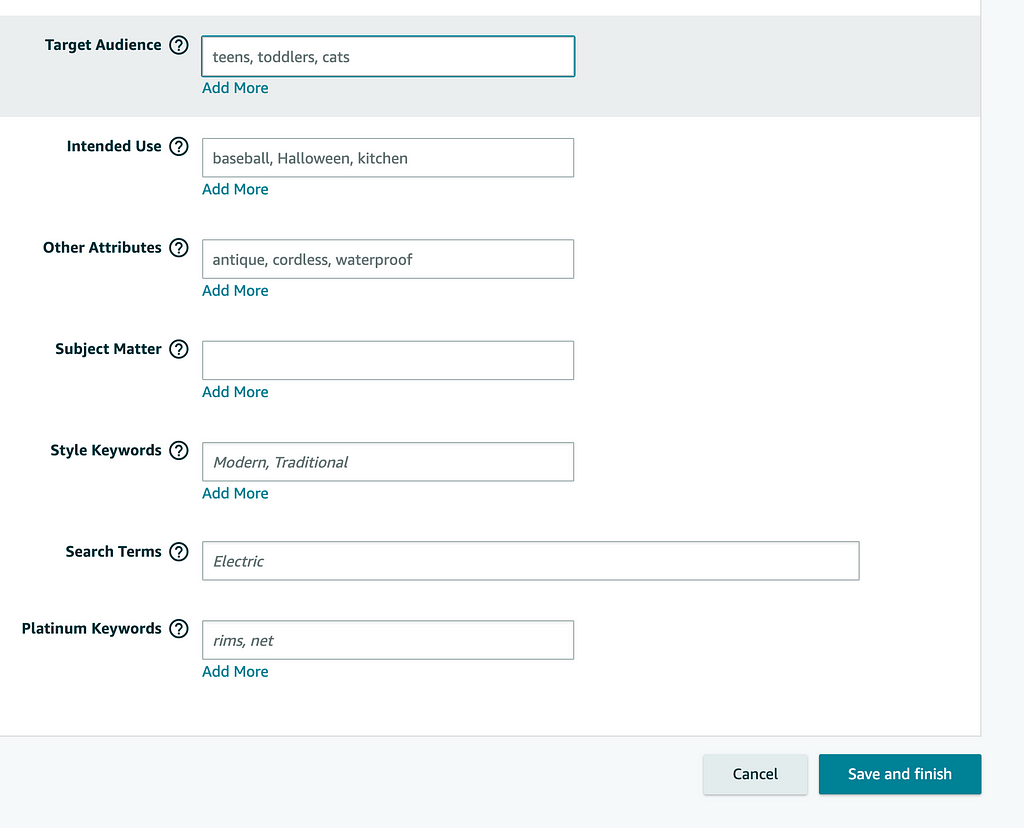
Find Hidden Sales Opportunities, Optimize Your Amazon PPC, and Crush The Competition
Amazon search terms, also known as keywords, are very important for driving sales on the platform. By using relevant and targeted keywords in product titles, bullet points, and product descriptions, sellers can increase the visibility of their products in search results, making them more likely to be seen and purchased by customers. Additionally, Amazon’s search algorithm uses keywords to determine the relevance of products to a customer’s search query, so optimizing keywords can also help to improve a product’s ranking in search results.
Analyzing Amazon search data can be a great way for Amazon Seller Central merchants to understand what customers are looking for and how they interact with your products.
If you’re an agency, brand, or Amazon seller just getting started, learning how to analyze this data can help you improve your sales by giving you insight into what customers are searching for when they visit the site.
It can also help you find organic search and Amazon PPC opportunities for keyword optimization, refine product descriptions and discover long-tail keywords or common misspellings used in customer searches.
Toward the end of the post, we detail how you can ditch the manual report downloads to leverage a fully automated, code-free pipeline of the official Amazon SP-API.
What is Amazon’s Search Terms report?
The Amazon Search Terms report includes data on the keywords that customers have used to search for products on the platform, as well as the number of times each keyword was searched and the number of times a product was viewed or purchased as a result of that search. The report can also include data on the conversion rate or the percentage of customers who viewed a product after searching for a specific keyword and then making a purchase.
The report may also include data on the search terms that are not performing well, where you can see which keywords are not driving any traffic or sales, and you can adjust your strategy accordingly.
Here is how Amazon describes the report;
Discover what products are winning the most clicks and conversions on strategic search terms. Assess the impact of your marketing campaigns by monitoring trends.
The report dataset shows popular searches that reflect keywords potential customers search for on Amazon. By looking at these terms, you can get an idea of what people are looking for, create strategies for optimizing keyword targeting, or get a sense of product relevance to demand.

The report will show the frequency of each term, relevant search terms to a category, and directional product performance. Here are the data points available in the report;
- Department
- Search Term
- Search Frequency Rank
- #1 Clicked ASIN
- #1 Product Title
- #1 Click Share
- #1 Conversion Share
- #2 Clicked ASIN
- #2 Product Title
- #2 Click Share
- #2 Conversion Share
- #3 Clicked ASIN
- #3 Product Title
- #3 Click Share
- #3 Conversion Share
Why do I need to use the Search Terms report?
There are a few main reasons why you might want to use the Search Terms report:
- Explore how you can optimize a product title or description since you can look for the relevance of terms to your listing(s).
- Discover any relevant products or hidden keywords competitors may be using. This may help you identify additional keywords you want to target organically or in your Sponsored Products ads.
- Refine your key metrics to include actual terms and their influence on product sales.
- Build a keyword target list for potential keywords or duplicate keywords aligned with customer data or observed competitive activity.
- On a regular basis, store the data to create a long-term snapshot of the report every day so you can, over time, report on trends you see for search term changes daily or month-to-month.
How to analyze the Amazon Search Terms report?
So, how do you analyze the data? First, understand the keywords which ultimately reflect user purchase intent.
There are several ways to analyze the Amazon Search Terms report to gain insights and make data-driven decisions for optimizing your product sales;
- Identify high-performing keywords: Sort the report by “sales” or “units sold” to see which keywords drive the most conversions for a product. You should focus on optimizing these keywords in your product titles and descriptions.
- Look for long-tail keywords: Long-tail keywords, which are longer and more specific phrases, tend to have a lower search volume but a higher conversion rate. Look for long-tail keywords in your report that have high sales or units sold, and consider adding them to your product listing or targeting them in your ad campaigns.
- Analyze your competitors: Look at the search terms that customers use to find products similar to yours. This can give you an idea of the keywords and phrases that work well for your competitors and help you identify opportunities to differentiate your product.
- Identify negative keywords: Look for keywords that are not relevant to your product and consider adding them as negative keywords in your ad campaigns.
- Track and measure your progress: Regularly review your data and track the changes to product listings.
How to Use the Amazon Search Terms Report for Optimizing Your Product Listing
You can use the report to understand the broader Amazon marketplace better. The report lets you see the terms people have used to find your product and insight into the competition and market trends.
For example, suppose you see that people are searching for your product with specific words in their query (like “large” or “black”). In that case, it makes sense that those keywords should be included in your title because they’re relevant to what people are looking for when they come across yours within Amazon’s marketplace.
You sell outdoor lighting, specifically “LED Outdoor String Lights.” Some people will search for “outdoor string lights,” and others will search for “patio lights” or “backyard lights.” If you only optimize for “Outdoor String Lights,” you’ll miss revenue opportunities.
Product Content Optimization: “Backend Keywords”
When you sell products on Amazon, optimizing your listings so they appear at the top of relevant search results is a top priority.
Amazon uses keywords to help your listings appear in the right search results. Optimizing your backend keyword can help your product stand out among competitors. Here are the backend keyword options for a given listing:

The search team report helps you do the research and refinement to enhance your listings.
Using keywords in MYE tests
Amazon offers a tool called Manage Your Experiments. This tool lets you run A/B tests (also known as split tests) on your brand’s listings content. Here is how they describe the benefits;
Experiments let you compare two versions of content against each other so you can see which performs better. At the end of an experiment, you can review which version performed the best and then publish the winning content. By running experiments, you can learn how to build better content that appeals to your customers and helps to drive more sales.
This is a perfect opportunity to use what you learned from search terms to test the impact on product listing content.
Understanding the limitations of the report
When using Amazon’s Search Terms report, it’s important to remember that the data you are looking at is not a complete, absolute picture of what is happening on Amazon. While the report is expansive, this report shows only a small subset of all the keywords people search for when looking for Amazon products.
The keyword searches shown in this report may only represent some of those who have searched for your product or even those who have purchased your product. However, you can overcome some of the limitations of any one report by creating a longer time horizon, a “unified” data set.
How do you overcome report limitations? Unify your data!
Looking at report data over time is essential to get the most out of this report. If you look at each report as a stand-alone data set, you need the power to see trends or patterns over a longer time horizon.
Fusing reports daily into a unified search data set is how data-driven sellers build powerful growth engines of search activity. There is no need to rely on third parties for search data when you can get it directly from Amazon.
Here are several benefits of creating a private, owned-by-you, unified database of search data;
- Understand what may be relevant keywords or irrelevant Keywords as they relate to your specific product offering
- Refine your PPC campaign by understanding the broader trends for exact keywords and their search volume estimates over a longer time horizon
- Inform any new product Launches with a comprehensive view of category-accurate keywords and their search frequency rank
- Adopt a data-driven view of the exact search volume for essential search terms by building your database to explore, query, and visualize.
- Create customized product reports with your actual sales volumes and associated numeric rank for associated keywords
- Start tracking competitor ASINs on an ongoing basis, allowing you to frequently create additional insights linked to actual business outcomes like your ASC order reports.
- Use the data to optimize your advertising budgets, including adjustments to any daily budget as you look to improve the efficiency of campaigns run on Amazon, Google, Facebook, or elsewhere.
Unifying search data unlocks new ways to use data to inform business decisions with performance metrics fueled by real-life purchase intent-based search queries.
Get Started With Amazon Brand Analytics Search Terms — For Free
Keep using manual file downloads or start using SP-API data automation? Direct, automated access to first-party search data gives you everything you need to create a private Amazon Brand Analytics Tool for your business. Openbridge offers an automated, code-free data connector for Amazon Search Terms. You can have the following;
- Unified search term data into industry-leading data destinations like Amazon Redshift, Amazon Redshift Spectrum, Google BigQuery, Snowflake, Azure Data Lake, and Amazon Athena.
- With search term data consolidated, use your favorite business intelligence, data visualization, SQL, or data science tools like Google Data Studio, Tableau, Microsoft Power BI, Looker, or Amazon Quicksight for valuable insights, custom search analytics dashboard, or brand dashboard for performance metrics.
Tap into new audience insights, optimize advertising activities or marketing campaigns, or discover competitor insights that accelerate your sales growth.
Sign up for a 30-day free trial of our fully-automated Amazon Search Term data today!
References
- How to download the Amazon Search Terms report?
- Amazon Brand Analytics Search Terms: Untapped Potential
How To Analyze Amazon Search Terms To Drive Sales Growth was originally published in Openbridge on Medium, where people are continuing the conversation by highlighting and responding to this story.
from Openbridge - Medium https://ift.tt/yevZRwS
via IFTTT